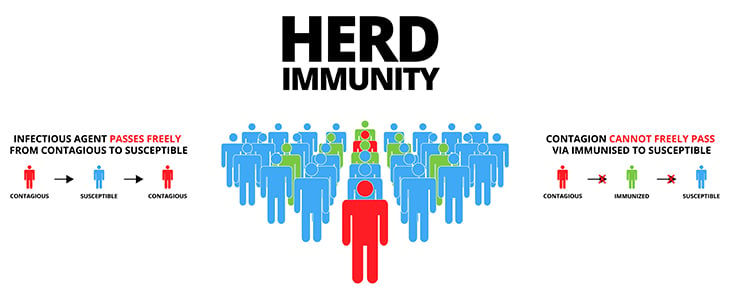Achieving Herd Immunity in the Ongoing Pandemic
Many questions remain in relation to the current COVID-19 pandemic. When vaccines will be available? Which vaccine(s) will prove most efficacious? Will either natural infection or vaccines lead to long lasting protection? Among these unresolved issues, how to achieve herd immunity is a topic capturing the attention of many.
What is Herd Immunity?
Herd immunity, defines a state of protection from a specific infectious agent, which is achieved through natural infection and/or immunization of a population. When enough individuals are no longer susceptible, disease spread is curtailed and even those without immunity are protected. The fraction of any given population that needs to be protected to reach herd immunity, or the herd immunity threshold, depends partly on the properties of the infectious agent and its rate of transmission within any given population (Randolph et al. 2020).

As an example, the measles virus is highly contagious with a reproductive number (R₀) value of 12-18, meaning that an infected individual has the potential to spread disease to as many as 18 susceptible individuals. For measles, maintaining herd immunity requires protection of ~95% of the population (Omer et al. 2020). Because the resulting immunity following measles vaccination is long lived, efforts to establish and maintain herd immunity through immunization, with a few exceptions, have prevented major outbreaks (Sanyaolu et al. 2019).
In contrast, seasonal influenza’s R₀ is in the range of 0.9-2.1, and therefore achieving herd immunity would require protection in up to ~52.3% of individuals. However, while having a lower threshold, achieving herd immunity through seasonal influenza vaccination is complicated by sub-optimal vaccine coverage, related to strain variations which reduce vaccine effectiveness. Hypothetically in this scenario, if an influenza vaccine was ~50% effective, the entire population would have to receive the vaccine to approach herd immunity (Grech et al. 2020).
SARS-CoV-2 Herd Immunity
In the current coronavirus pandemic, SARS-CoV-2 has an estimated R₀ of 2-3, which would require protection in ~60% of the population to achieve herd immunity (Salzberger et al. 2020, Randolph et al. 2020). Without a vaccine and inability to predict vaccine efficacy, this is obviously an estimate. Many unknowns remain regarding the quality of immunity that natural infection or a future vaccine may confer, which would impact the path to achieving herd immunity.
Lessons learned from common cold inducing viruses (HCoVs), which similar to SARS-CoV-2 belong to the coronavirus family, indicate that immunity to HCoVs is not long-lived (Edridge et al. 2020). For example, HCOV reinfections may occur as early as 6 months. Although, antibody levels remain generally stable within a 6 month period post HCoV infection, antibodies decline thereafter allowing for reinfection, which occur more frequently after 12 months. The observation by several studies that SARS-CoV-2 antibody levels substantially decline after ~2-3 months post symptom onset, is leading researchers to suggest that a similar scenario of reinfection cycles may occur with SARS-CoV-2, as occurs with common cold coronaviruses (Edridge et al. 2020, Long et al. 2020, Seow et al. 2020).
The good news so far is that few cases of SARS-CoV-2 reinfections have been documented. A total of ~25 cases of SARS-CoV-2 reinfection have been reported worldwide ( COVID-19 reinfection tracker). However, among these cases, reinfection was confirmed by next generation sequencing (NGS) and findings published for only ~16 individuals (Hong Kong, India, India, Qatar, Netherlands, and USA).
Currently, there is no clear consensus on the rate of SARS-CoV-2 reinfections, partly due to limitations in testing practices and the great percentage of asymptomatic cases. However, the occurrence of SARS-CoV-2 reinfections supports the idea that under specific conditions only a limited and sub-optimal immune response that is short lived occurs. Ultimately, the quality of immune responses to both natural infections and to a future vaccine will dictate the threshold level of protection required in a population to achieve herd immunity.
SARS-CoV-2 Herd Immunity: Vaccines versus Natural Infection
Herd immunity is a concept usually evaluated and thought of in association with the use of vaccines. Estimates of herd immunity thresholds help guide public measures to ensure effective vaccination strategies (Fine et al. 2011). Achieving herd immunity within a population is complicated by many factors beyond the biology of the host-pathogen interactions and consequent immune responses. A series of socio-economic variables such as age demographics, access to health care, social distancing measures, among many more factors will negatively or positively impact herd immunity threshold predictions (Randolph et al. 2020).
In the ongoing pandemic, experts agree that the best path towards achieving SARS-CoV-2 herd immunity is through the use of vaccines, as relying on immunity derived from natural infections would involve massive loss of human lives.
Reference
Edridge, A. W. D. et al. Seasonal coronavirus protective immunity is short-lasting. Nat. Med. (2020) doi:10.1038/s41591-020-1083-1.
Fine, P., Eames, K. & Heymann, D. L. ‘Herd immunity’: A rough guide. Clin. Infect. Dis. (2011) doi:10.1093/cid/cir007.
Grech, V. & Borg, M. Influenza vaccination in the COVID-19 era. Early Hum. Dev. (2020) doi:10.1016/j.earlhumdev.2020.105116.
Long, Q. X. et al. Clinical and immunological assessment of asymptomatic SARS-CoV-2 infections. Nat. Med. (2020) doi:10.1038/s41591-020-0965-6.
Omer, S. B. Herd Immunity and Implications for SARS-CoV-2 Control. JAMA (2020). doi:10.1001/jama.2020.20892.
Randolph, H. E. & Barreiro, L. B. Herd Immunity: Understanding COVID-19. Immunity (2020) doi:10.1016/j.immuni.2020.04.012.
Salzberger, B. et al. Epidemiology of SARS-CoV-2. Infection (2020) doi:10.1007/s15010-020-01531-3.
Sanyaolu, A. et al. Measles Outbreak in Unvaccinated and Partially Vaccinated Children and Adults in the United States and Canada (2018-2019): A Narrative Review of Cases. Inquiry (United States) (2019) doi:10.1177/0046958019894098.
Seow, J. et al. Longitudinal evaluation and decline of antibody responses in SARS-CoV-2 infection. medRxiv (2020) doi:10.1101/2020.07.09.20148429.
- Like (5)
- Reply
-
Share
About Us · User Accounts and Benefits · Privacy Policy · Management Center · FAQs
© 2025 MolecularCloud



